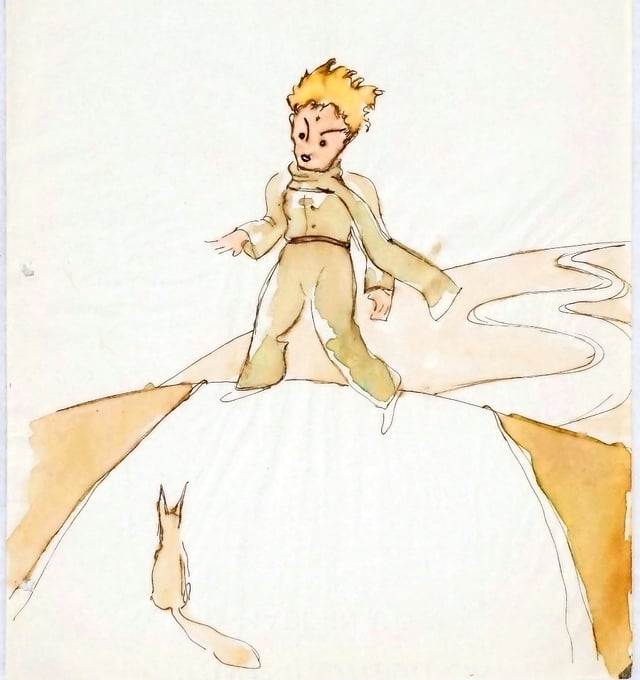Art World
A Long-Lost Set of Sketches From Beloved Classic ‘The Little Prince’ Has Turned Up in a Swiss Storage Facility
The drawings by Antoine de Saint-Exupéry were discovered among a Swiss art collector's papers.

The drawings by Antoine de Saint-Exupéry were discovered among a Swiss art collector's papers.

Sarah Cascone

A set of lost sketches for The Little Prince, the beloved novella by French pilot, writer, artist, and aristocrat Antoine de Saint-Exupéry, has been discovered in storage in Winterthur, a city in Northern Switzerland. The sketches belonged to Bruno Stefanini, who had purchased them at auction in 1986.
The local collector, who made his fortune in real estate, died in December. In the months since, the organization he founded, the Stiftung für Kunst, Kultur und Geschichte (Foundation for Art, Culture, and History), has been combing through his archives, sorting, photographing, and cleaning the many works in Stefanini’s collection.
Among the unexpected finds was the series of early drawings from The Little Prince, which Saint-Exupéry wrote between 1941 and 1943, while living in New York. Done on thin airmail paper, the undated drawings feature familiar scenes from the fantastical children’s book: the Little Prince and the fox, the snake who ate an elephant, and the drunkard to whom the prince pays a visit. One page also includes a love letter from the author to his wife.
“They are in surprisingly good shape,” Elisabeth Grossmann, the cultural foundation’s curator, told the Swiss publication Der Landbote. She said she plans to reach out to the Morgan Library & Museum, which owns the preliminary manuscript and drawings for the book.

Antoine de Saint-Exupéry, newly discovered preparatory sketches for The Little Prince. Courtesy of the Stiftung für Kunst, Kultur und Geschichte, Winterthur, Switzerland.
“Saint-Exupéry’s drawings are so simple—generally just a few strokes of pen and ink and a bit of watercolor on the most ephemeral of paper…. But they are full of such energy, delight, and poignancy.” Christine Nelson, the Morgan’s curator of literary and historical manuscripts, told artnet News in an email, noting that she was eager to learn more about the foundation’s find. “It’s always good news when additional drawings surface—they allow us to glimpse the birth of a character that has had a profound impact on readers for the past 75 years.”
The Morgan acquired its 140-page manuscript and 35 full-page preliminary drawings from American journalist Silvia Hamilton, a friend of the author, in 1968. Saint-Exupéry had delivered the papers to her before returning to Europe in 1943 to serve as a reconnaissance pilot in World War II.
Assigned to fly a mission out of Corsica in July 1944, Saint-Exupéry never returned. For years, his fate was one of the great mysteries of aviation history, perhaps second only to the disappearance of Amelia Earhart. In 1998, a Marseille fisherman found a silver ID bracelet bearing Saint-Exupéry’s name in his net. Later, Luc Vanrell, French diver and marine archaeologist, found the wreckage of his plane in 2005, even identifying the German soldier who shot Saint-Exupéry down. Just last month, Vanrell spoke with the BBC about the discovery.
The Morgan staged an exhibition dedicated to Saint-Exupéry’s time in New York in 2014, displaying in the US for the first time the bracelet he was wearing when he was shot down.
The newly discovered Saint-Exupéry drawings are among some 60,000 objects in Stefanini’s collection of artworks and historical artifacts. The son of an Italian immigrant, Stefanini was a very private figure, last seen in public, according to Wikipedia, in 2014, on the occasion of the opening of “A Passion for Swiss Art Treasures,” an exhibition of his holdings at the Kunstmuseum Bern.
A multi-year legal battle between the foundation and Stefanini’s children was resolved in the foundation’s favor earlier this year. In recent months, the foundation’s work has grown in scope, the initial team of four employees doubling in order to better organize the inventory, a process expected to take years.